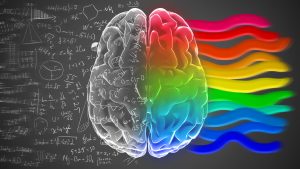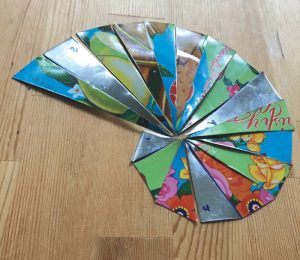Mathematics and the arts: A powerful, productive, pedagogical pairing
Reprinted with permission from Teachers Magazine of the BC Teachers Federation
Many of us grew up with a school curriculum that separated the “hard” disciplines of mathematics and sciences from the “soft” disciplines of the visual and performing arts. This binary still exists in our society as people talk about the STEM subjects (science, technology, engineering, mathematics), and sometimes have difficulty understanding STEAM (STEM plus arts). While there is no doubt that mathematics and science have close connections, I’d like to introduce you to the equally close connections mathematics has to the arts, and to suggest that arts-based math pedagogy can help you reach students who are more oriented toward the arts than the sciences.
technology, engineering, mathematics), and sometimes have difficulty understanding STEAM (STEM plus arts). While there is no doubt that mathematics and science have close connections, I’d like to introduce you to the equally close connections mathematics has to the arts, and to suggest that arts-based math pedagogy can help you reach students who are more oriented toward the arts than the sciences.
I was one of those students in my secondary school years in Hamilton, Ontario. My strongest subject was mathematics; I found it easy and natural to understand its logical patterns, but what I loved was poetry and language, music and theatre. It took an amazing math teacher to make me see that these subjects were intimately linked. Bob McVean had us learning about the beauty of math through the arts and history, philosophy and games, with projects that had many of us “artsy” students falling in love with mathematics.
Thinking about arts-based mathematics pedagogy is easier if we think of mathematics as more than just calculating and solving equations. Einstein called math “the poetry of logical ideas”; mathematician Keith Devlin describes math as “the science of patterns”; and I see math as “the study of patterns  and the patterns-of-patterns.” If we think of mathematics in these ways, we are immediately transported to the world of rhythmic and tonal patterns of music and dance, visual patterns of arts and design, and patterns of sounds and words in poetry. It becomes natural to experiment with mathematical patterning through pedagogical activities as diverse as weaving, drawing, map-making, theatre, and photography.
and the patterns-of-patterns.” If we think of mathematics in these ways, we are immediately transported to the world of rhythmic and tonal patterns of music and dance, visual patterns of arts and design, and patterns of sounds and words in poetry. It becomes natural to experiment with mathematical patterning through pedagogical activities as diverse as weaving, drawing, map-making, theatre, and photography.
We can think of in-depth mathematical understanding as being able to represent and experience a mathematical pattern in several different forms, and grasp and communicate how and why they are equivalent. These representations of mathematical patterns go beyond T-charts, graphs, and equations to include poetry, sculpture, painting, and beadwork. Mathematical structures become inspiration for creating innovative art, and art reciprocally inspires deeper understanding of mathematics.
But how to bring the arts into our math teaching in meaningful ways? I suggest starting small, stretching ourselves as teachers by adding just one or two arts-based activities each year to more familiar math pedagogies. Some starting points are suggested below. After a few years, each of us will have a good handful or two of math-arts learning activities in our teaching repertoire, ready to share with colleagues—activities that have the power to transform our students’ experiences and lifelong attitudes about mathematics. It is important to integrate assessment of this work into our math learning evaluations, along with more conventional tests, quizzes, and homework. As teachers, we already have many assessment strategies for project work, including rubrics and self- and peer-assessment.
Arts-based approaches can be woven into regular lessons and into take-home projects, so that they don’t require extra instructional hours. Galleries of student mathematical art displays can enliven our classrooms, hallway displays, and performance evenings, and spark interest in others who are moved by beautiful mathematical patterns. Arts-based work can also stimulate collaboration between teachers specializing in math and the arts, and encourage appreciation and exchange with our colleagues.
Resources
Online
One very rich source of mathematics and arts ideas is the Bridges Organization (bridgesmathart.org) that has brought together mathematical artists, teachers, and makers for 25 years. The Bridges galleries, archives, short film festivals, mathematical fashion shows, and poetry readings are all available for free online, and offer almost limitless inspiration for teaching mathematics via the arts (and vice versa). It’s also worth checking out the affiliated Journal of Mathematics and the Arts, which often has free issues and articles available.
I also strongly recommend the many fascinating and inspiring videos available online by mathematical artists like Vi Hart and her dad, Bridges and Museum of Mathematics co-founder George Hart, spanning topics from mathematical food to hexaflexagons to juggling, bell-ringing and music boxes.
The National Museum of Mathematics (momath.org) in New York City is another excellent resource for free, live online programming involving the arts. There are plenty of great starting points for designing K–12 lessons, activities, and projects.
Pedagogy projects
I’d like to introduce you to some of the math and art pedagogy projects from UBC teacher candidates from my classes in recent years (some of whom you might know as colleagues in your schools now), and to my own short film:
Ali Hasan (who is also a Jeopardy! star) and Colin Grabowski, along with John Hawthorne, explore the pedagogy of binary and other bases through Marc and Marion Chamberland’s art in New Math Teachers Riff on Kandinsky in Binary.
Sam Milner and Carolina Azul Duque show ways to learn classic geometry through whole-body movement by Dancing Euclidean Proofs on the beach.
My 2021 Bridges short film contribution is an exploration of a mathematical braid pattern through music, poetry, and weaving: Seven Strands of Alphabetically Braided Crows.
Books
Fibre arts: Making Mathematics with Needlework: Ten Papers and Ten Projects; Crafting by Concepts: Fiber Arts and Mathematics; and Figuring Fibers (three books co-edited by sarah-marie belcastro & Carolyn Yackel)
Dance: Math Dance with Dr. Schaffer and Mr. Stern: Whole Body Math and Movement Activities for the K–12 Classroom (Karl Schaffer, Eric Stern & Scott Kim); Discovering the Art of Mathematics: Dance (Christine von Renesse et al., available for free download); Math on the Move (percussive dance and math, by Malke Rosenfeld)
Music: Rhythm of Math: Teaching Mathematics with Body Music (Keith Terry & Linda Akiyama); Discovering the Art of Mathematics: Music (Christine von Renesse et al., available for free download)
Sculpture and origami: Discovering the Art of Mathematics: Sculpture (Julian Fleron et al., available for free download); The Complete Book of Origami Polyhedra (Tomoko Fuse); Twists, Tilings, and Tessellations (Robert Lang)
Currently, I am fascinated (one might say obsessed) with a beautiful, simple spiral called the Wurzelschnecke (pictured right), or Spiral of Theodorus, a.k.a. the Pythagorean Spiral: a construction that is amazingly simple to draw or fold with origami (see Tomoko Fuse’s Spiral Origami, Art, Design), and can be understood by students from Grade 8 up, needing only an introduction to the Pythagorean Theorem. I’ve been collaborating with others to explore the Wurzelschnecke through art and design forms including mathematical furniture-making, fashion, and culinary arts.
the Wurzelschnecke (pictured right), or Spiral of Theodorus, a.k.a. the Pythagorean Spiral: a construction that is amazingly simple to draw or fold with origami (see Tomoko Fuse’s Spiral Origami, Art, Design), and can be understood by students from Grade 8 up, needing only an introduction to the Pythagorean Theorem. I’ve been collaborating with others to explore the Wurzelschnecke through art and design forms including mathematical furniture-making, fashion, and culinary arts.
Wishing you and your students many artful, mathematical years of learning and enjoyment ahead.
Susan Gerofsky (she/her), is Associate Professor of Mathematics Education, UBC

